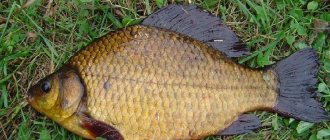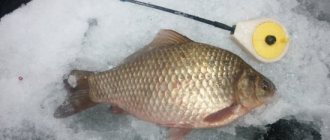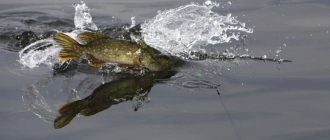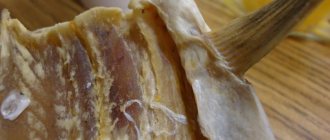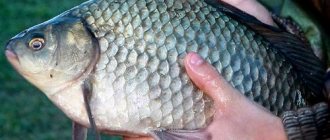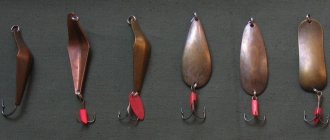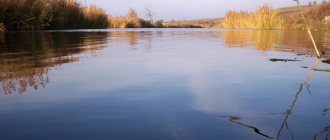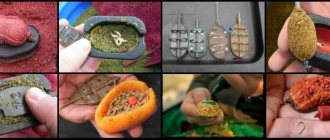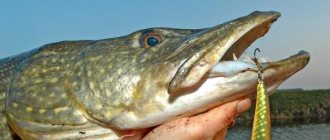Advantages of artificial breeding of pike
To understand how to grow pike in artificially created conditions, you should know all the necessary information about this type of fish. The common pike is a heat-loving fish that lives in fresh waters. She prefers places with slow water movement, such as:
- river bays;
- floodplain reservoirs;
- lakes.
Pike living in a pond grow 4-5 times faster than those living in their natural environment. If there is a sufficient amount of food in the reservoir, the weight of fingerlings can reach 400 g, and sometimes 500-800 g. In winter, the fish undergo an active feeding process.
To obtain 1 kg of weight gain, fingerlings will need to eat only 2.5 kg of fish. Fry and larvae, planted in feeding ponds to produce offspring, eat:
- water beetles;
- bedbugs;
- dragonflies;
- tadpoles;
- frogs;
- small fish.
Pike farming is economically profitable.
Its meat has good taste and is not high in calories, which is why it is highly valued in many countries. The fillet of this fish is expensive, and its caviar is even more expensive. Pike act as pond cleaners because... they feed on a variety of beetles, moths, leeches and parasitic organisms. This helps cleanse the reservoir and has a beneficial effect on the life activity of both the pike itself and other species of fish. It grows and reproduces quickly, so there will be no problems with breeding it in an artificial reservoir.
Pike breeding
Under natural conditions, females of this species begin to reproduce at the age of two to three years, males at four years.
Spawning starts soon after the ice melts, when the water temperature does not exceed 3-6 °C. Females retreat to shallow water (depth up to one meter), where they begin to splash noisily and actively move within the spawning area. Each female is accompanied by several males.
The female is capable of laying from 17 to 215 thousand eggs. Pike have them quite large - 3 mm in diameter - and in the first days they are quite sticky, so they often stick to aquatic vegetation. But then most of them roll to the bottom, where their further development occurs.
Since the eggs end up in shallow water from the very beginning, when the water level in the reservoir drops significantly, most of the eggs die. This, for example, is typical for reservoirs, the water level in which is regulated by humans and is therefore very variable.
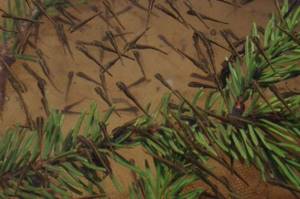
The larvae hatch from eggs during the entire second week after spawning and begin to feed independently, eating microscopic crustaceans. Having reached a length of 12-15 mm, young pike move onto carp larvae, which spawn after the pike. Five-centimeter young pike finally switch to fish.
It is interesting that pike river fish often spawn in swimming lakes, which quickly lose connection with the river after the end of the spring flood. When there is a shortage of food in such reservoirs, hatched fry grow extremely unevenly. Representatives of one generation can differ in size by 2 or more times. In such conditions, the food chain is built on the basis of cannibalism, when very small pike feed on plankton, and young animals feed on fry, while themselves becoming prey for last year’s and older pike. This happens especially often in Yakutia and northern Canada, where similar pike lakes exist on a permanent basis.
How to arrange a pond
To grow pike you need a large reservoir. The fish stocking density should be no more than 2 individuals per 100 m² (if there is a small amount of food, there should be fewer individuals).
This fish is unpretentious to its living conditions: the pond can be overgrown with various vegetation, and the water in it can be cloudy. When a pond has already been stocked with pike, it is necessary to monitor its behavior and activity level. It is unacceptable for sick fish to live in a pond.
Purchasing a fry
Pike fry can be purchased from specialized farms, or you can raise them yourself.
Using artificial fertilization of eggs, you can get 10 times more fry than naturally in the wild. During artificial breeding, fewer pike larvae die.
To create the necessary conditions for the life of the eggs, they are kept in special glass containers. Thus, the fry is born after 10 days. For comparison, in the natural environment this process occurs within 1 month. The head of the fry is difficult to see, because part of it closes the gallbladder, which contains nutrients to ensure vital functions for the near future. After 30 days, the fry grow up to 5 cm in length and begin to actively search for food.
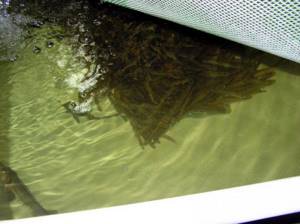
In fish farms, you can keep a population of productive fish, from which you can obtain planting material for stocking the pond with pike. To breed fingerlings and further select viable and rapidly developing individuals, fish must be caught in large feeding ponds and reservoirs.
At 1 year of life they are kept in ponds along with carp. Large and medium-sized individuals are selected for breeding. It would also be advisable to select only females that grow much faster than males (it is possible to determine their gender in the autumn season by the presence of reproductive products during autopsy). Having determined the weight of males per large female, it is necessary to select 5 fingerlings with the weight characteristic of males.
Next year they can be kept in ponds for breeding carp broodstock. Thus, adult pikes will eat crucian and carp fry.
The required number of pike breeding stock for a farm is calculated depending on the demand for fry for breeding in artificial ponds. The spawning characteristics of these fish are also taken into account. In the natural environment, no more than 5,000-10,000 fry are produced from 1 nest.
During the process of straining, males produce a small volume of sperm. In this regard, their milk is not enough for mature females. To increase the amount of milk, sperm from males that have been killed is used.
In order for the sperm to be mobile for a longer period of time and its ability to fertilize to be higher, saline solution is added to the milk. To fertilize 3 females, you will need from 500 ml to 1 liter of this solution.
With natural fertilization, there are at least 3 males per 1 female. Using the milk of a killed male (weighing 175 g), up to 50 females can be fertilized. To do this, you need to simultaneously pour the ripened caviar and milk into an enamel bowl. After 30 seconds, you need to stir the eggs using a bird feather. After this, you need to add water and stir again after 15 seconds (so that the duration of fertilization does not exceed 1 minute).
Types of pike with photos and descriptions
Currently, there are 7 species of pike known to represent this genus. Their differences are related to the conditions in which they live, their appearance and other features. For example:
Common pike
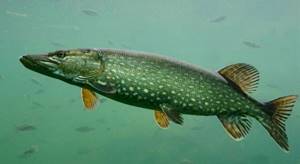
This is the typical and most common representative of this family. This species is found in most freshwater bodies of Eurasia and North America. Its favorite habitats are water areas with thickets of aquatic vegetation located closer to the coastline.
Redfin or American pike
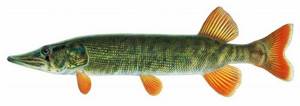
Its habitat is the eastern regions of North America. The variety is represented by two subspecies: northern red pike and southern (grass) pike. Representatives of these subspecies do not grow more than half a meter in length and do not gain weight more than 1 kg. This subspecies is distinguished by a slightly shortened mouth. At the same time, the fins do not have an orange coloring, as is typical for the common pike.
Musk Pike

This is the largest, and at the same time the rarest representative of this family. The Indians dubbed this predator the “ugly pike.” This predator also has a second name – “giant pike”, which is associated with its enormous size. Adults reach a length of 2 meters, while gaining weight up to 35 kg. Depending on the living conditions, the predator may have a silver, brown-brown or green tint. There may be either spots or vertical stripes on the side surface of the pike.
Striped or black pike
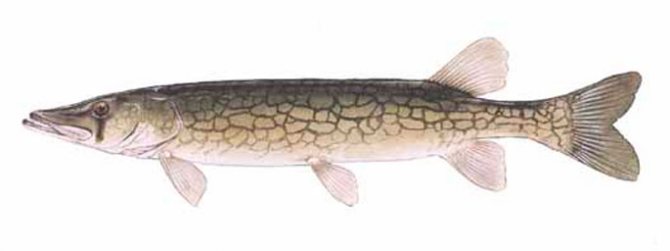
It can grow up to 0.6 meters in length and weigh about 2 kg, although there is information that a pike of this species weighing 4 kg was caught. In appearance, the striped pike resembles the northern pike. At the same time, it is characterized by a pattern in the form of a mosaic located on the sides of the predator. In addition, she has a dark, characteristic stripe above her eyes.
Amur pike

This type of predator is distinguished by the fact that it is somewhat smaller in size compared to the common pike. Individual individuals can grow to a length of slightly more than 1 meter, weighing no more than 20 kg. Its peculiarity is its small scales, which have a silvery or golden-greenish tint. The color of the Amur pike's scales is more reminiscent of the taimen, as it has numerous black-brown spots randomly scattered throughout the body, starting from the head and ending with the tail.
Several years ago, another species was isolated - the Italian pike, which was previously considered a common pike.
On the territory of France, just 4 years ago, a species of pike was identified as the Aquitaine pike. The species is not so well known, as it was described quite recently.
Interesting fact! Hybrid specimens cannot reproduce in natural conditions, so an independent population of these individuals does not exist.
Do I need to feed and what?
To provide the fry with food and increase their yield, part of the reservoir should be separated using a mesh with small cells. Up to 12 perches that have reached sexual maturity are released there. The young perch will be born later and will become food for the pike fry.
If there is not enough food in the pond, the growth of the fry slows down. In this regard, during the breeding of this fish, on the 15th day from the moment the larvae emerge from the eggs, they must be transplanted into a feeding pond. There the fry will be able to obtain food in the required quantity.
You need to know how to catch a fry without harming it. They should be caught with caution: water from the pond must be drained gradually, while simultaneously adding fresh water. It is easiest to catch fry using catchers directly in front of the spillway bed.
To prevent the fry from getting lost in the grass, it must first be mowed and removed.
Features of fishing on a pond
Ponds become covered with ice earlier than other bodies of water and thaw later. But the water in them warms up faster than in rivers and lakes. Typically, fish stop spawning in ponds in May. After this, you can catch a large predator using a spinning rod. In this case, the fisherman must take into account the fact that:
- 1. The most active bite is observed in early June. Perch and pike are caught using wobblers and spinners near the shore.
- 2. In mid-June, the water in most ponds begins to bloom. The fish becomes lazy and unpredictable. During this period, you can only count on a catch in the early morning or evening.
- 3. By August, the fry grow up, and active biting resumes. Predators attack small poppers, wobblers, and light jig baits right near the shore. It's easy to see where the pike or perch are. The fish are where the fry fan out across the surface of the reservoir.
- 4. In autumn, the water in ponds cools quickly. Predators go deep. Hunting for them becomes difficult and often fruitless.
Culinary value of pike
Pike fillet is rich in nutrients, minerals and vitamins. Eating it has a positive effect on the condition of the skin and mucous membranes, the health of the digestive and nervous systems. The meat of this fish normalizes blood sugar levels and acts as an antioxidant. It should be present in the diet if thyroid function is impaired.
Fish contains microelements that have a positive effect on metabolic processes in the body:
- magnesium;
- potassium;
- phosphorus.
Among other things, it contains B vitamins. Regular consumption of this fish (in any form) will reduce the likelihood of cardiac arrhythmia.

Pike fillet contains 84 kcal.
The nutritional value of the product is:
- proteins - 18.4 g;
- fats - 1.1 g;
- carbohydrates - 0 g.
Pike breeding as a business
Pond maintenance as a business has been popular for many decades. The range of equipment for artificial reservoirs is large. It is selected depending on the needs of the individual species of fish that will be grown in it. To raise pike at home, you need to purchase a standard set of mechanisms, which includes:
- Gravity biofilter. It is used to purify water from various types of contaminants and products of flowering of aquatic vegetation.
- Compressors for supplying oxygen to the water column. In principle, they are identical to those installed in home aquariums. The difference lies in the size of the equipment.
- Pumps for pumping in and out of water from a reservoir.
- Feeders to feed the fish.
It is also necessary to install a water supply for a closed RAS, which must take into account all the features of local conditions. Therefore, it is recommended to conduct a preliminary analysis of local conditions and possible risks and prospects in the market.
The selection of equipment for a reservoir has one important feature: the smaller its size, the greater the number of different mechanisms that must be placed in it to create optimal conditions for the life of fish. Therefore, to grow fish in a country house or on a farm, the size of the reservoir must be at least 100 m².
Pike lifestyle
In any body of water, pike prefers thickets of aquatic vegetation. As a rule, she just stands motionless, waiting for prey. After the pike sees suitable prey, a sharp jerk follows. It is curious that the pike always swallows its prey from the head, even if it grabs it across the body, it will unwrap it.
Even large pike prefer shallow waters. There have been cases when very large specimens were caught in small lakes at depths of up to 40-50 centimeters. For pike, the oxygen content in water is important, so in small bodies of water it can die during long and cold winters. It dies when the oxygen content in water decreases to 3 mg/liter.
It is important to know that pike will always wait for its prey where there is some kind of shelter. For example, large individuals, unlike small and medium-sized pike, can be found at depth, but they will still look for algae, snags, etc. On sunny days, even large pikes like to go out into shallow waters and bask in the sun; you can often see large fish at depths of 20-30 centimeters near the shore.

